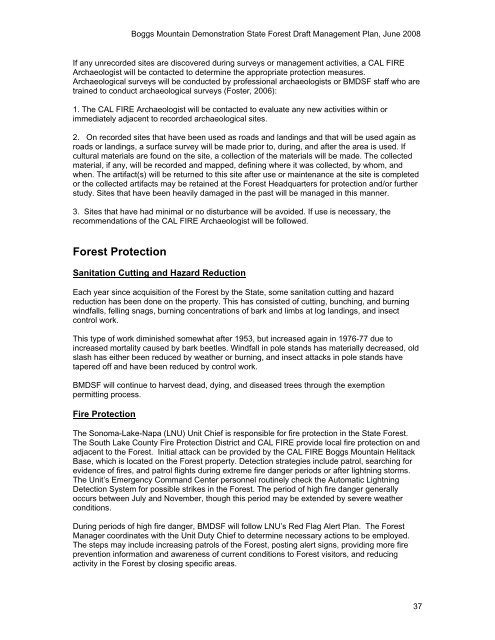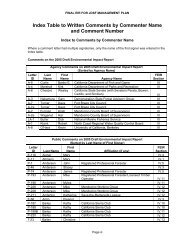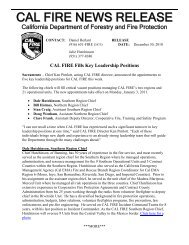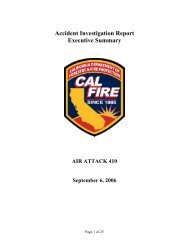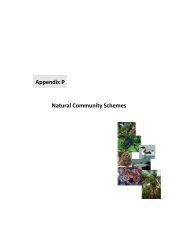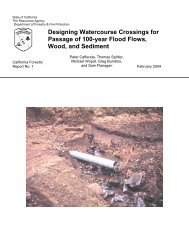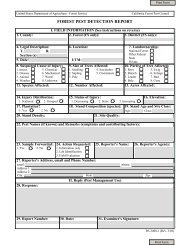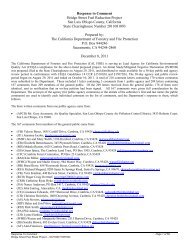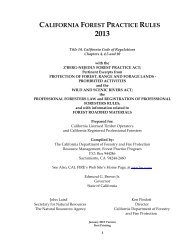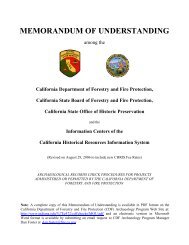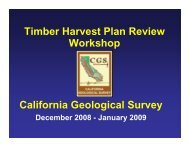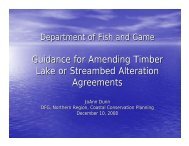Boggs Mountain Demonstration State Forest Draft ... - Cal Fire
Boggs Mountain Demonstration State Forest Draft ... - Cal Fire
Boggs Mountain Demonstration State Forest Draft ... - Cal Fire
Create successful ePaper yourself
Turn your PDF publications into a flip-book with our unique Google optimized e-Paper software.
<strong>Boggs</strong> <strong>Mountain</strong> <strong>Demonstration</strong> <strong>State</strong> <strong>Forest</strong> <strong>Draft</strong> Management Plan, June 2008<br />
If any unrecorded sites are discovered during surveys or management activities, a CAL FIRE<br />
Archaeologist will be contacted to determine the appropriate protection measures.<br />
Archaeological surveys will be conducted by professional archaeologists or BMDSF staff who are<br />
trained to conduct archaeological surveys (Foster, 2006):<br />
1. The CAL FIRE Archaeologist will be contacted to evaluate any new activities within or<br />
immediately adjacent to recorded archaeological sites.<br />
2. On recorded sites that have been used as roads and landings and that will be used again as<br />
roads or landings, a surface survey will be made prior to, during, and after the area is used. If<br />
cultural materials are found on the site, a collection of the materials will be made. The collected<br />
material, if any, will be recorded and mapped, defining where it was collected, by whom, and<br />
when. The artifact(s) will be returned to this site after use or maintenance at the site is completed<br />
or the collected artifacts may be retained at the <strong>Forest</strong> Headquarters for protection and/or further<br />
study. Sites that have been heavily damaged in the past will be managed in this manner.<br />
3. Sites that have had minimal or no disturbance will be avoided. If use is necessary, the<br />
recommendations of the CAL FIRE Archaeologist will be followed.<br />
<strong>Forest</strong> Protection<br />
Sanitation Cutting and Hazard Reduction<br />
Each year since acquisition of the <strong>Forest</strong> by the <strong>State</strong>, some sanitation cutting and hazard<br />
reduction has been done on the property. This has consisted of cutting, bunching, and burning<br />
windfalls, felling snags, burning concentrations of bark and limbs at log landings, and insect<br />
control work.<br />
This type of work diminished somewhat after 1953, but increased again in 1976-77 due to<br />
increased mortality caused by bark beetles. Windfall in pole stands has materially decreased, old<br />
slash has either been reduced by weather or burning, and insect attacks in pole stands have<br />
tapered off and have been reduced by control work.<br />
BMDSF will continue to harvest dead, dying, and diseased trees through the exemption<br />
permitting process.<br />
<strong>Fire</strong> Protection<br />
The Sonoma-Lake-Napa (LNU) Unit Chief is responsible for fire protection in the <strong>State</strong> <strong>Forest</strong>.<br />
The South Lake County <strong>Fire</strong> Protection District and CAL FIRE provide local fire protection on and<br />
adjacent to the <strong>Forest</strong>. Initial attack can be provided by the CAL FIRE <strong>Boggs</strong> <strong>Mountain</strong> Helitack<br />
Base, which is located on the <strong>Forest</strong> property. Detection strategies include patrol, searching for<br />
evidence of fires, and patrol flights during extreme fire danger periods or after lightning storms.<br />
The Unit’s Emergency Command Center personnel routinely check the Automatic Lightning<br />
Detection System for possible strikes in the <strong>Forest</strong>. The period of high fire danger generally<br />
occurs between July and November, though this period may be extended by severe weather<br />
conditions.<br />
During periods of high fire danger, BMDSF will follow LNU’s Red Flag Alert Plan. The <strong>Forest</strong><br />
Manager coordinates with the Unit Duty Chief to determine necessary actions to be employed.<br />
The steps may include increasing patrols of the <strong>Forest</strong>, posting alert signs, providing more fire<br />
prevention information and awareness of current conditions to <strong>Forest</strong> visitors, and reducing<br />
activity in the <strong>Forest</strong> by closing specific areas.<br />
37


